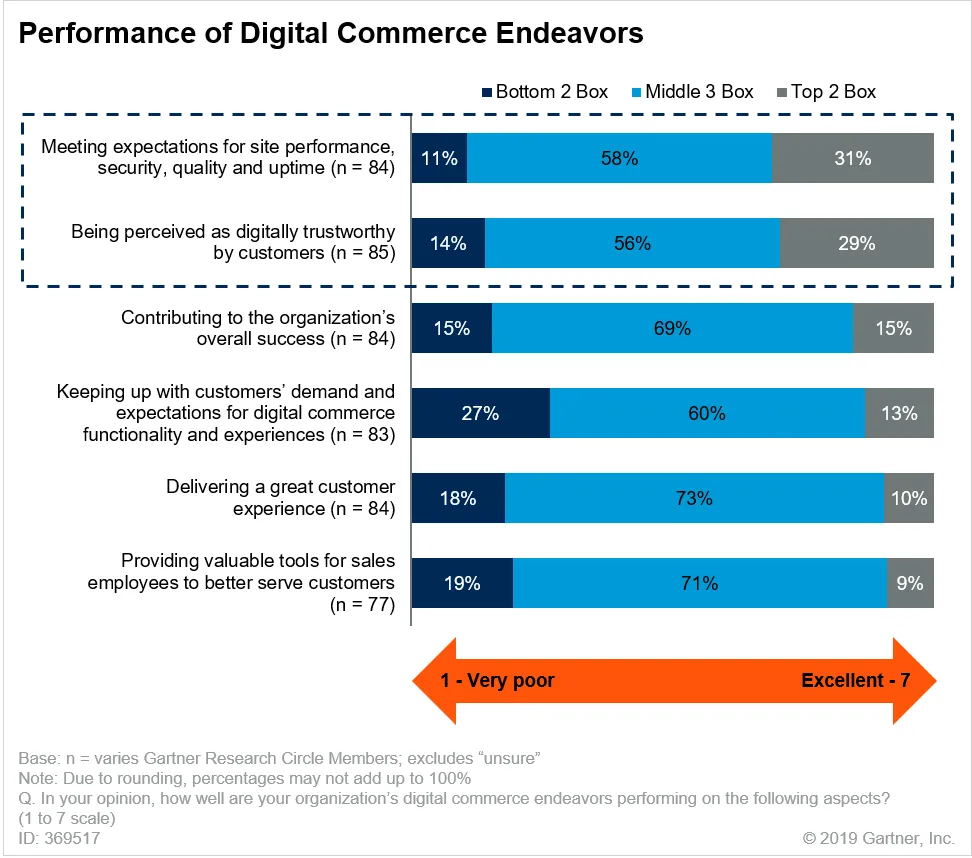

Posted in Digital Commerce
May 7, 2019
Disconnected data complicates marketing efforts & customer experience
Imagine this. You’ve just launched a new product line across multiple digital sales platforms. All channels, websites, phone apps, etc., have had a design revamp and are looking great. Ads are rolling and people are visiting the site in record numbers. In fact, sales are already spiking and so are user accounts. This is looking like a successful marketing effort and the numbers reflect it! Good job, marketing team! In a day or two, your team plans to review the data and make adjustments as needed.
A week passes and you don’t have all of the data you need to make adjustments. The accounting team is backlogged with data entry and hasn’t been able to get accurate totals from each channel. The fulfillment team is at full capacity, even borrowing staff from other departments. Management is starting to worry about inventory resupply. Customer service times have skyrocketed as an influx of requests is coming in. Customers ordering through your app are not seeing their orders within their account on your website. Don’t worry though, weather the storm and in a week or so everything will be sorted out and back to normal.
But another week is too late. As a marketer, you need to be working in real-time (or close to it). Opportunities are being missed, but what can you do? Not much if you don’t have the data you need to make decisions.
This scenario paints a bit of a dark picture, but it’s one that many businesses suffer from. The truth is, disconnected data, or data that is not being passed automatically between the different software components within a business's commerce architecture, is one of the biggest issues facing online companies today. And as you can see, it affects the entire organization, including marketers and your customers.
If you're feeling this, you're not alone.
Doom and gloom stories aside, in a recent Gartner report conducted from a survey sample size of 88 organizations, Gartner found that
"Despite the need to deliver great customer experiences, a large majority of survey respondents report poor performance in this area. Delivery is not easy and most organizations rate themselves low in their ability to do so"1
The report then goes on to state,
"Perhaps worse yet, only about one-third of respondents rate their organizations highly in the area of digital commerce site performance (i.e., security, quality and uptime) — a foundational requirement for 24/7 customer experience."1

Source: Gartner, "Survey Analysis: Organizations Need to Improve the Customer Experience to Fully Exploit Digital Commerce," 4 February 2019, Penny Gillespie.
Yikes! As you can see, these are common struggles that many businesses are facing. You can take some comfort in the fact that you're not alone in this struggle as perfecting digital commerce is hard! But, it's also a great opportunity to gain a competitive edge.
Third-party solutions are the new norm
Aligning business and customer data, and getting it to flow throughout your commerce architecture, is not an easy task.
A recent report that surveyed 183 ecommerce retail executives about their technology needs found that 66% of retailers opted to use a vendor when implementing new technology rather than build it in-house, up from 51% a year earlier. These retailers rely on third-party provided solutions (SaaS or otherwise) because they simply don’t have the ability to build the technology in-house.
Using these highly specialized solutions has become a reality for many businesses because they’re easier to implement and typically cost-effective for what you get. The trade-off, of course, is that you’re not necessarily in control of your data and therefore disconnected data is a likely outcome. This leads to time-consuming manual data entry bottlenecks that we call swivel chair processes.
A couple of co-workers of mine recently recorded a webinar that shows some of this in action using two VERY popular SaaS solutions, Shopify and ReCharge. And by very popular, I mean that ~15% of ecommerce websites are run on Shopify and ~53% of all online recurring billing and subscriptions happen through ReCharge. That is a lot! With those numbers, you would think that these solutions together are a winning combination. For many businesses starting out, they are. But for many others that are established and growing, disconnected data between the two can’t be avoided. Watch the webinar to see what I mean.
What disconnected data means for the marketer and customer experience
Getting back to the marketer and customer, disconnected data can complicate everyone's efforts, including marketers and customers.
For the marketer
The scenario mentioned in the beginning gives us a basic picture of the marketer's plight. Think of it this way. Departments within an organization typically talk and rely on each other for one thing or another. A lot of talk goes on behind the scenes as they work together towards a common goal. Everyone has their own job to do, but there is a lot going on that impacts how it all comes together. Luckily, if someone needs something from another person or department, all that person needs to do is pick up the phone or send an email to get it.
The software components that are used by each department should also ‘talk’ in a similar way, passing data as needed. The reality is that many components are siloed and don’t do this. In this case, someone needs to manually gather that data and share it, which can be a slow process, especially if people are busy (which they likely are).
Marketing is all about acting on available data, the more data the better. Today’s websites look great and the platforms running them typically allow marketers to do everything they need upfront. Behind the scenes is another story. Disconnected data complicates the life of the marketer.
For the customer
The customer experience is also affected by the flow of data. Here is an example using email marketing of good flowing of data. There is a fine line between acceptable and spam. Many marketing email service providers, MailChimp being a dominant one, have done a great job at making sure their platforms integrate and ‘talk’ with popular ecommerce platforms. Sending abandoned cart emails and other automated promotions are a breeze to set up and customers can easily sign up and update their subscription preferences if they get too overwhelmed. This is great, but customers expect all interactions with your brand to be similar.
Now, what if a customer who has a recurring subscription plan wants to cancel their subscription. Easy! All they need to do is log in to the website and update their subscription preferences, right? You would think so, but if the business is running on the Shopify/ReCharge combination mentioned earlier, it might not be so easy. Both Shopify and ReCharge have their own customer admin pages with separate logins. A common issue (as shown in the webinar) happens when customers log in to the wrong account and change their preferences. The two systems aren’t integrated well enough to know a change has been made, so the customer might still get billed even though they’ve cancelled the subscription. How mad would that unexpected charge make you? I bet the customer service representatives could give you an idea. Now, as a marketer, try and get these customers back.
The solution to disconnected data makes everyone’s life easier, not just marketers
If you’re familiar with the Acro Commerce blog, you’ll already know the answer to disconnected data. The answer is commerce architecture, specifically knowing which commerce architecture is best suited to your business and then defining and implementing a strategy around it.
Shopify, ReCharge, MailChimp, and any other software component used within the operation of your business are all pieces of your overall commerce architecture. As a business grows and changes, various components are added, removed and replaced over time. A commerce architecture strategy looks at the whole picture and makes sure that each component fits. It’s a way of ensuring everything is integrated and automated to the extent needed. It also gives management and operational teams a non-technical, high-level overview of the business which can facilitate discussion on where improvements should be made, now and in the future. Everyone understands.
As I mentioned earlier, getting all of the components to ‘talk’ is not an easy task, but understanding your commerce architecture is a logical first step towards the ultimate business platform. This can be done through a discovery consultation that takes your current architecture into account and maps out the data in an easy-to-understand document. A strategy phase would come next to identify where and how improvements can be made. From there, implementing the strategy becomes straightforward. Click the link below to learn more about the elements of effective discovery and strategy.
1 - Gartner, "Survey Analysis: Organizations Need to Improve the Customer Experience to Fully Exploit Digital Commerce," 4 February 2019, Penny Gillespie


